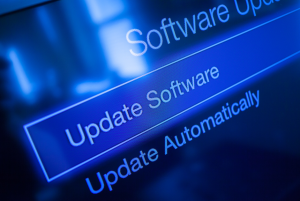 “Please keep your computer locked and plugged in while we perform our weekly maintenance” is a sentence that you may be familiar with regarding your company’s general IT policy. Keeping the software on your computer and phone updated is crucial for maintaining optimal performance, security, and compatibility. Luckily, software developers and hardware manufacturers work together to ensure that this process is as easy and seamless as possible for their users. Some best practices for software updating involve regular checks for updates (“over-the-air”), prompting installation of patches and updates, and ensuring compatibility with existing systems. By adhering to these practices, users and developers alike can minimize the risk of security breaches, enhance functionality, and mitigate potential compatibility issues.
“Please keep your computer locked and plugged in while we perform our weekly maintenance” is a sentence that you may be familiar with regarding your company’s general IT policy. Keeping the software on your computer and phone updated is crucial for maintaining optimal performance, security, and compatibility. Luckily, software developers and hardware manufacturers work together to ensure that this process is as easy and seamless as possible for their users. Some best practices for software updating involve regular checks for updates (“over-the-air”), prompting installation of patches and updates, and ensuring compatibility with existing systems. By adhering to these practices, users and developers alike can minimize the risk of security breaches, enhance functionality, and mitigate potential compatibility issues.
Software is complex and humans (nor computers for that matter) are perfect. When a developer or team of developers write software for a specific hardware platform (say your computer or phone) there are many variables that must be considered to ensure compatibility across the stack. Naturally some of these variables might go unnoticed or not given a second quality assurance pass as others which leads to subpar and outdated code. This might not be an immediate issue, but as other areas of the overall system (that being your computer or phone in this example) are updated and tweaked those bugs begin to crop up. To add on to that complexity, new features requested by users or deemed a good idea by the developers might require a rework of previous areas that at the time were deemed acceptable.
Security plays a big role in why software updates are crucial for a healthy system. Software used and studied by potentially billions of users globally allows for vulnerabilities previously unknown to be found and exploited. Proactive developers can create fixes for these vulnerabilities and push them out to users via software updates and patches which mitigates the overall potential risk created by those vulnerabilities being discovered. Because both bad actors and the field of security are constantly evolving there truly is no ‘perfectly’ updated system.
For the Clerk of Courts office, where sensitive legal information is handled daily, the importance of software updating cannot be overstated. Security vulnerabilities in outdated software pose a significant risk to the confidentiality and integrity of legal documents and sensitive data. Hackers can attempt to exploit known vulnerabilities to gain unauthorized access to systems, potentially compromising case files, confidential communications, and other critical information, but rest assured the Clerk’s office uses many defensive tactics to thwart such attempts.
Additionally, maintaining compatibility with other systems and applications is essential for seamless operation within the Clerk of Courts office. Outdated software may not be compatible with newer technologies or integrations, leading to disruptions in service and productivity. By regularly updating software, the Clerk of Courts office can ensure smooth interoperability with external systems and applications, minimizing downtime and workflow interruptions.

